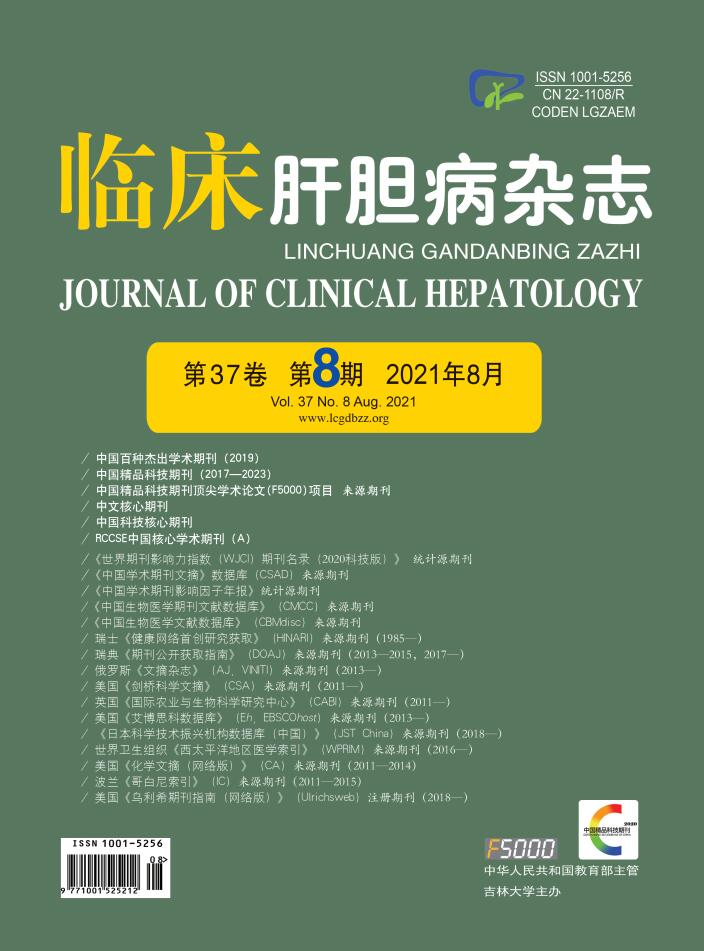| [1] |
SUNG H, FERLAY J, SIEGEL RL, et al. Global cancer statistics 2020: GLOBOCAN estimates of incidence and mortality worldwide for 36 cancers in 185 countries[J]. CA Cancer J Clin, 2021, 71(3): 209-249. DOI: 10.3322/caac.21660. |
| [2] |
European Association for the Study of the Liver; European Organisation for Research and Treatment of Cancer. EASL-EORTC clinical practice guidelines: Management of hepatocellular carcinoma[J]. J Hepatol, 2012, 56(4): 908-943. DOI: 10.1016/j.jhep.2011.12.001. |
| [3] |
MALUCCIO M, COVEY A. Recent progress in understanding, diagnosing, and treating hepatocellular carcinoma[J]. CA Cancer J Clin, 2012, 62(6): 394-399. DOI: 10.3322/caac.21161. |
| [4] |
BREEDIS C, YOUNG G. The blood supply of neoplasms in the liver[J]. Am J Pathol, 1954, 30(5): 969-977.
|
| [5] |
LLOVET JM, REAL MI, MONTAÑA X, et al. Arterial embolisation or chemoembolisation versus symptomatic treatment in patients with unresectable hepatocellular carcinoma: A randomised controlled trial[J]. Lancet, 2002, 359(9319): 1734-1739. DOI: 10.1016/S0140-6736(02)08649-X. |
| [6] |
LO CM, NGAN H, TSO WK, et al. Randomized controlled trial of transarterial lipiodol chemoembolization for unresectable hepatocellular carcinoma[J]. Hepatology, 2002, 35(5): 1164-1171. DOI: 10.1053/jhep.2002.33156. |
| [7] |
GOLFIERI R, GIAMPALMA E, RENZULLI M, et al. Randomised controlled trial of doxorubicin-eluting beads vs conventional chemoembolisation for hepatocellular carcinoma[J]. Br J Cancer, 2014, 111(2): 255-264. DOI: 10.1038/bjc.2014.199. |
| [8] |
FACCIORUSSO A, DI MASO M, MUSCATIELLO N. Drug-eluting beads versus conventional chemoembolization for the treatment of unresectable hepatocellular carcinoma: A meta-analysis[J]. Dig Liver Dis, 2016, 48(6): 571-577. DOI: 10.1016/j.dld.2016.02.005. |
| [9] |
CHANG Y, JEONG SW, YOUNG JANG J, et al. Recent updates of transarterial chemoembolilzation in hepatocellular carcinoma[J]. Int J Mol Sci, 2020, 21(21): 8165. DOI: 10.3390/ijms21218165. |
| [10] |
Bureau of Medical AdministrationNational Health Commission of the People's Republic of China. Guidelines for diagnosis and treatment of primary liver cancer in China (2019 edition)[J]. J Clin Hepatol, 2020, 36(2): 277-292. DOI: 10.3969/j.issn.1001-5256.2020.02.007. |
| [11] |
BARGELLINI I, SACCO R, BOZZI E, et al. Transarterial chemoembolization in very early and early-stage hepatocellular carcinoma patients excluded from curative treatment: A prospective cohort study[J]. Eur J Radiol, 2012, 81(6): 1173-1178. DOI: 10.1016/j.ejrad.2011.03.046. |
| [12] |
European Association for the Study of the Liver. EASL clinical practice guidelines: Management of hepatocellular carcinoma[J]. J Hepatol, 2018, 69(1): 182-236. DOI: 10.1016/j.jhep.2018.03.019. |
| [13] |
RAOUL JL, FORNER A, BOLONDI L, et al. Updated use of TACE for hepatocellular carcinoma treatment: How and when to use it based on clinical evidence[J]. Cancer Treat Rev, 2019, 72: 28-36. DOI: 10.1016/j.ctrv.2018.11.002. |
| [14] |
LIANG L, LI C, DIAO YK, et al. Survival benefits from adjuvant transcatheter arterial chemoembolization in patients undergoing liver resection for hepatocellular carcinoma: A systematic review and meta-analysis[J]. Therap Adv Gastroenterol, 2020, 13: 1756284820977693. DOI: 10.1177/1756284820977693. |
| [15] |
WANG Z, REN Z, CHEN Y, et al. Adjuvant transarterial chemoembolization for HBV-related hepatocellular carcinoma after resection: A randomized controlled study[J]. Clin Cancer Res, 2018, 24(9): 2074-2081. DOI: 10.1158/1078-0432.CCR-17-2899. |
| [16] |
LOPEZ-LOPEZ V, ROBLES-CAMPOS R, BRUSADIN R, et al. ALPPS for hepatocarcinoma under cirrhosis: A feasible alternative to portal vein embolization[J]. Ann Transl Med, 2019, 7(22): 691. DOI: 10.21037/atm.2019.10.57. |
| [17] |
TRUTY MJ, VAUTHEY JN. Uses and limitations of portal vein embolization for improving perioperative outcomes in hepatocellular carcinoma[J]. Semin Oncol, 2010, 37(2): 102-109. DOI: 10.1053/j.seminoncol.2010.03.013. |
| [18] |
ZHANG CW, DOU CW, ZHANG XL, et al. Simultaneous transcatheter arterial chemoembolization and portal vein embolization for patients with large hepatocellular carcinoma before major hepatectomy[J]. World J Gastroenterol, 2020, 26(30): 4489-4500. DOI: 10.3748/wjg.v26.i30.4489. |
| [19] |
KUDO M, ARIZUMI T, UESHIMA K. Assessment for retreatment (ART) score for repeated transarterial chemoembolization in patients with hepatocellular carcinoma[J]. Hepatology, 2014, 59(6): 2424-2425. DOI: 10.1002/hep.26760. |
| [20] |
KLOECKNER R, PITTON MB, DUEBER C, et al. Validation of clinical scoring systems ART and ABCR after transarterial chemoembolization of hepatocellular carcinoma[J]. J Vasc Interv Radiol, 2017, 28(1): 94-102. DOI: 10.1016/j.jvir.2016.06.012. |
| [21] |
SALEM R, LEWANDOWSKI R, ROBERTS C, et al. Use of Yttrium-90 glass microspheres (TheraSphere) for the treatment of unresectable hepatocellular carcinoma in patients with portal vein thrombosis[J]. J Vasc Interv Radiol, 2004, 15(4): 335-345. DOI: 10.1097/01.rvi.0000123319.20705.92. |
| [22] |
MIKELL JK, DEWARAJA YK, OWEN D. Transarterial radioembolization for hepatocellular carcinoma and hepatic metastases: Clinical aspects and dosimetry models[J]. Semin Radiat Oncol, 2020, 30(1): 68-76. DOI: 10.1016/j.semradonc.2019.08.005. |
| [23] |
VILGRAIN V, PEREIRA H, ASSENAT E, et al. Efficacy and safety of selective internal radiotherapy with yttrium-90 resin microspheres compared with sorafenib in locally advanced and inoperable hepatocellular carcinoma (SARAH): An open-label randomised controlled phase 3 trial[J]. Lancet Oncol, 2017, 18(12): 1624-1636. DOI: 10.1016/S1470-2045(17)30683-6. |
| [24] |
SALEM R, GORDON AC, MOULI S, et al. Y90 radioembolization significantly prolongs time to progression compared with chemoembolization in patients with hepatocellular carcinoma[J]. Gastroenterology, 2016, 151(6): 1155-1163. e2. DOI: 10.1053/j.gastro.2016.08.029. |
| [25] |
SALEM R, GABR A, RIAZ A, et al. Institutional decision to adopt Y90 as primary treatment for hepatocellular carcinoma informed by a 1, 000-patient 15-year experience[J]. Hepatology, 2018, 68(4): 1429-1440. DOI: 10.1002/hep.29691. |
| [26] |
ANDO E, TANAKA M, YAMASHITA F, et al. Hepatic arterial infusion chemotherapy for advanced hepatocellular carcinoma with portal vein tumor thrombosis: Analysis of 48 cases[J]. Cancer, 2002, 95(3): 588-595. DOI: 10.1002/cncr.10694. |
| [27] |
KUDO M, MATSUI O, IZUMI N, et al. JSH consensus-based clinical practice guidelines for the management of hepatocellular carcinoma: 2014 update by the Liver Cancer Study Group of Japan[J]. Liver Cancer, 2014, 3(3-4): 458-468. DOI: 10.1159/000343875. |
| [28] |
LYU N, LIN Y, KONG Y, et al. FOXAI: A phase Ⅱ trial evaluating the efficacy and safety of hepatic arterial infusion of oxaliplatin plus fluorouracil/leucovorin for advanced hepatocellular carcinoma[J]. Gut, 2018, 67(2): 395-396. DOI: 10.1136/gutjnl-2017-314138. |
| [29] |
LYU N, KONG Y, MU L, et al. Hepatic arterial infusion of oxaliplatin plus fluorouracil/leucovorin vs. sorafenib for advanced hepatocellular carcinoma[J]. J Hepatol, 2018, 69(1): 60-69. DOI: 10.1016/j.jhep.2018.02.008. |
| [30] |
HE MK, LE Y, LI QJ, et al. Hepatic artery infusion chemotherapy using mFOLFOX versus transarterial chemoembolization for massive unresectable hepatocellular carcinoma: A prospective non-randomized study[J]. Chin J Cancer, 2017, 36(1): 83. DOI: 10.1186/s40880-017-0251-2. |
| [31] |
HE M, LI Q, ZOU R, et al. Sorafenib plus hepatic arterial infusion of oxaliplatin, fluorouracil, and leucovorin vs sorafenib alone for hepatocellular carcinoma with portal vein invasion: A randomized clinical trial[J]. JAMA Oncol, 2019, 5(7): 953-960. DOI: 10.1001/jamaoncol.2019.0250. |
| [32] |
MEI J, TANG YH, WEI W, et al. Hepatic arterial infusion chemotherapy combined with PD-1 inhibitors plus lenvatinib versus PD-1 inhibitors plus lenvatinib for advanced hepatocellular carcinoma[J]. Front Oncol, 2021, 11: 618206. DOI: 10.3389/fonc.2021.618206. |
| [33] |
SAEKI I, YAMASAKI T, MAEDA M, et al. Evaluation of the "assessment for continuous treatment with hepatic arterial infusion chemotherapy" scoring system in patients with advanced hepatocellular carcinoma[J]. Hepatol Res, 2018, 48(3): e87-e97. DOI: 10.1111/hepr.12932. |









 本站查看
本站查看




 DownLoad:
DownLoad: